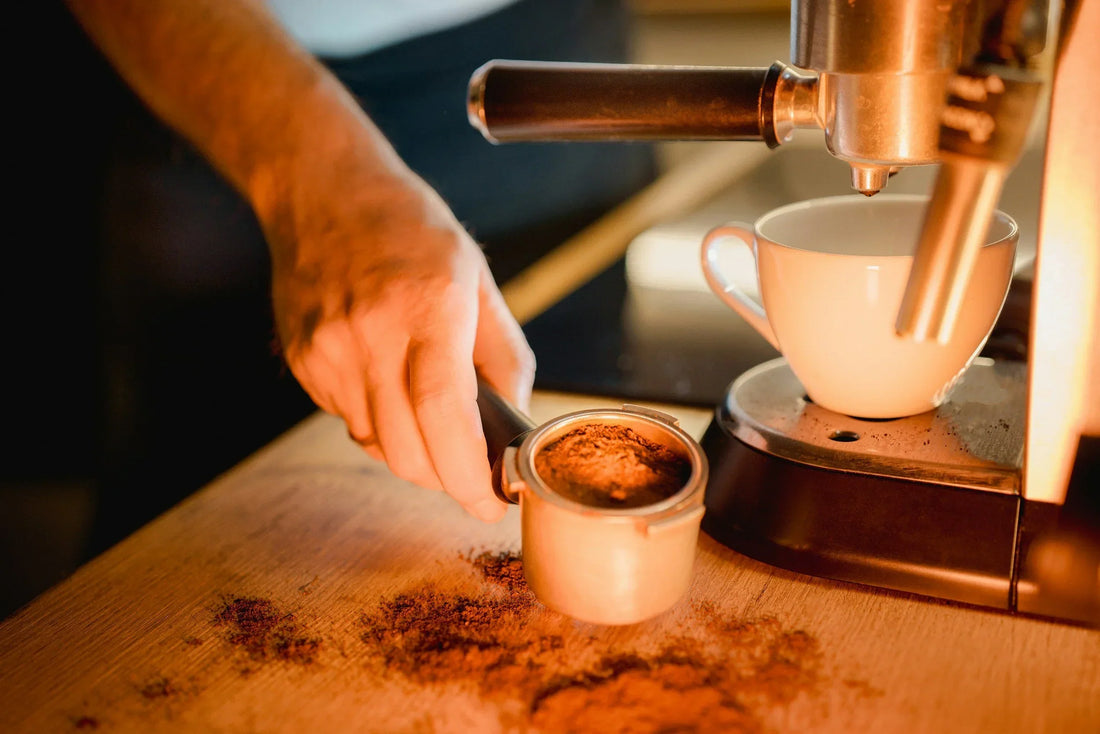
Why Your Home Coffee Never Tastes Like Café Coffee (and How to Fix It)
Share
rTLDR;
Your home coffee doesn’t taste like café coffee because of four main factors: bean freshness, grind consistency, water quality, and brewing precision. By using freshly roasted beans, a burr grinder, filtered water, and consistent brewing ratios, you can dramatically improve flavor and achieve café-level quality at home.
Why Café Coffee Tastes Better Than Home Brewed

Café coffee often tastes smoother, richer, and more balanced than what you brew at home. That’s not luck or magic; it’s process and precision. Baristas at Milk & Honey Coffee Co. use controlled recipes, professional equipment, and fresh ingredients to achieve that consistent flavor.
Key reasons cafés outperform home setups include:
-
Trained baristas who understand extraction and technique
-
Commercial machines that maintain stable pressure and temperature
-
Freshly roasted beans used at peak flavor
-
Consistent ratios and brewing parameters
These differences add up to one thing: control. Every variable in café brewing is measured, repeated, and refined.
The Professionals’ Advantage

Professional baristas operate in a system built for precision. At Milk & Honey Coffee Co., every shot and pour follows strict ratios. Baristas use:
-
Digital scales for exact coffee-to-water ratios
-
Burr grinders that ensure uniform grind size
-
Machines calibrated daily to maintain pressure and temperature
This controlled workflow removes guesswork. Home brewers, by comparison, often measure by eye or use inconsistent tools. Even small changes in grind size or brew time can change flavor drastically.
Precision, Consistency, and Recipe Control

Cafés don’t rely on instinct alone. Recipes are documented and tested. For example, a standard espresso might use a 1:2 ratio — 18 grams of coffee yielding 36 grams of espresso in 25 seconds.
At home, guessing measurements often leads to over- or under-extraction.
-
Over-extraction makes coffee bitter.
-
Under-extraction leaves it sour and weak.
To fix this, weigh both coffee and water. Start with a 1:15 to 1:17 ratio for pour-over or drip methods. Record your results and adjust until you find balance.
Ideal Bean Freshness and Roast Profile

Café beans are roasted to order and used within days, not months. Freshness affects aroma and flavor. Once beans are roasted, they start losing volatile compounds that give coffee its depth.
To match café standards:
-
Buy from local or small-batch roasters.
-
Check the roast date — aim for beans used within three weeks.
-
Store in airtight containers away from light and moisture.
Avoid buying in bulk or pre-ground coffee. Freshly ground beans retain oils and aromatics that pre-ground coffee loses.
The Home Brewing Gap

Even with good beans, home coffee often tastes flat or harsh. Understanding why helps close the gap between your kitchen and a café like Milk & Honey Coffee Co.
Bean Quality and Freshness at Home

Most home brewers store beans for weeks or keep them in the fridge. Both habits dull flavor. Temperature changes cause condensation that degrades the beans.
To maintain freshness:
-
Store beans in a cool, dry, dark space.
-
Use an airtight container.
-
Avoid refrigeration or freezing unless vacuum-sealed.
Flat-tasting coffee usually means old beans or poor storage. Always grind just before brewing.
Grinder and Grind Size Inconsistencies

A burr grinder is essential for café-quality coffee. Blade grinders chop unevenly, producing fine dust and coarse chunks that extract unevenly. Burr grinders crush beans uniformly, improving extraction and consistency.
Recommended steps:
-
Use a burr grinder, not a blade grinder.
-
Adjust grind size for each method:
-
Fine for espresso
-
Medium for drip
-
Coarse for French press
-
Fine for espresso
-
Clean the grinder regularly to remove old oils.
An inconsistent grind is one of the biggest causes of poor flavor at home.
Water Quality and Brewing Temperature

Cafés use filtered water with balanced minerals. Tap water often contains chlorine or excess minerals that distort flavor. Brewing with poor water can make coffee taste metallic or dull. If you’ve ever wondered why use filtered water for coffee, it’s because clean, mineral-balanced water highlights the beans’ natural flavors instead of masking them.
To improve water quality and temperature:
-
Use filtered water with balanced mineral content.
-
Keep temperature between 195°F and 205°F.
-
Preheat your equipment to maintain stability.
Good water equals clean flavor and consistent extraction.
Brewing Method, Technique, and Repeatability

Each brewing method extracts coffee differently. Café baristas track time, dose, and flow. Home brewers often skip these steps, leading to unpredictable taste.
Tips for better consistency:
-
Stick to one method at a time — pour-over, French press, or drip.
-
Keep a brewing journal.
-
Use a timer to track brew time.
-
Stir or swirl during brewing to ensure even extraction.
Consistency makes your results repeatable, bringing you closer to café standards.
Equipment Investment and Maintenance

Commercial espresso machines cost more for a reason. They maintain exact pressure and heat stability. Home machines, while less advanced, can still perform well with care.
Basic maintenance checklist:
-
Descale machines every few weeks.
-
Clean portafilters and baskets after each use.
-
Replace gaskets and filters when worn.
-
Discard old grounds each morning before brewing fresh coffee.
Dirty or poorly maintained machines add bitterness and burnt flavors.
How to Make Home Coffee Taste Like Café Coffee

Now that you know what causes the difference, here’s how to close the gap.
Choose Fresh, Well-Roasted Beans

Start with quality beans. Look for single-origin or blends roasted within the last month. Buy from local roasters or reputable online sources.
Best practices:
-
Check the roast date, not expiration date.
-
Avoid supermarket coffee with vague labeling.
-
Store beans in airtight, opaque containers.
Fresh beans are the foundation of flavor.
Upgrade Your Grinder

A grinder is the most important upgrade you can make. A burr grinder improves consistency and control.
Steps to improve grind quality:
-
Calibrate the grinder for your brew method.
-
Test grind settings until extraction tastes balanced.
-
Clean the burrs weekly.
Even a basic burr grinder can transform your coffee quality.
Improve Water Quality and Temperature Control

Filtered water mimics café standards. Temperature stability prevents over- or under-extraction.
Practical actions:
-
Use a filter pitcher or bottled spring water.
-
Let boiled water sit for 30 seconds before brewing.
-
Avoid distilled water — minerals are essential for flavor.
Water makes up 98% of your coffee. Treat it as an ingredient.
Follow a Consistent Brewing Recipe

Precision turns good coffee into great coffee. Use a scale and timer every time.
Recommended starting points:
-
Ratio: 1 gram coffee to 15–17 grams water for pour-over or drip.
-
Brew time: 3–4 minutes for pour-over, 30 seconds for espresso.
-
Adjust to taste and record results.
Following a recipe brings repeatable results and consistency.
Maintain Your Equipment and Develop Habits

Clean tools make better coffee. Old oils and residue spoil flavor.
Routine cleaning steps:
-
Rinse and dry equipment after each use.
-
Deep clean weekly with mild detergent.
-
Backflush espresso machines as recommended.
Treat your gear like a barista treats theirs at Milk & Honey Coffee Co.
Match Brewing Method to Roast and Bean Type

Different beans perform best with certain methods. Understanding this connection improves your results.
Guidelines:
-
Light roast: Best for pour-over or Aeropress. Highlights floral or citrus notes.
-
Medium roast: Works well for drip or French press. Balanced flavor.
-
Dark roast: Suited for espresso or moka pot. Rich and bold.
Adapt your brewing style to the bean’s strengths.
Bonus Tips from Café Baristas

Baristas refine their skills daily. These pro tips can help you elevate your coffee at home.
-
Use a digital scale and timer. Precision equals consistency.
-
Account for humidity. Wetter days require a slightly coarser grind.
-
Buy from local roasters. Fresh supply improves flavor.
-
Keep notes. A brewing log helps you track improvements.
Barista habits make a difference over time.
Frequently Asked Questions
Q: Why does my home coffee taste bitter when café coffee tastes smooth?
A: Bitterness often comes from over-extraction or dirty equipment. Try a coarser grind, shorter brew time, and clean your tools regularly.
Q: Can I ever replicate café espresso at home?
A: You can get close. Focus on fresh beans, consistent grind, and proper machine pressure. True café espresso requires commercial-grade pressure, but flavor can come surprisingly close with practice.
Q: What’s the cheapest upgrade that improves flavor most?
A: A burr grinder. Consistent grind size impacts flavor more than almost any other factor.
Q: How long after roasting should I use beans?
A: Use beans between 7 and 21 days after roast. This window balances freshness and flavor development.
Q: Is freezing coffee beans good or bad?
A: Only if vacuum-sealed. Moisture ruins frozen beans if exposed to air.
